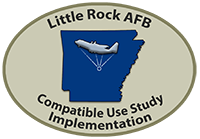Frequently Asked Questions
What is the Little Rock Air Force Base Compatible Use Study?
The Little Rock AFB Compatible Use Study (CUS) was a cooperative planning effort conducted as a joint venture between Little Rock AFB, Pulaski County, White County, Lonoke County, Cabot, Jacksonville, Sherwood and other jurisdictions and stakeholders in proximity to the base. The study was administered by the Jacksonville Economic Development and Cultural Alliance and co-funded through a grant from the Department of Defense (DOD), Office of Economic Adjustment (OEA).
The Little Rock Air Force Base Compatible Use Study aims to benefit both the Air Force and the surrounding region by:
- Preserving long-term land use compatibility between the installation and the surrounding communities;
- Sustaining the operational mission of the Air Force in nearby communities while protecting the quality of life of nearby residents and businesses;
- Enhancing communication and coordination among local and regional stakeholders; and
- Integrating the growth plans of the communities in the region with Air Force plans and mission operations.
What is the purpose of the Compatible Use Study?
The purpose of the Compatible Use Study is to identify means of promoting responsible land use near Little Rock AFB, to accommodate compatible growth and economic development in the region, to protect public safety and quality of life, and to sustain the mission of the Air Force in the region for the long-term. The Compatible Use Study evaluates ways to enhance communication and coordination among local and regional stakeholders with the goal being to protect land use compatibility as both the community and the Air Force plan for the future. The Compatible Use Study did not result in changes to land use, zoning, or how a property owner may use their property, though it identifies regulatory changes for the community to consider.
What does the CUS address?
The Compatible Use Study provides:
- An assessment of existing land use conditions near Little Rock AFB, Camp Robinson, and the Blackjack Drop Zone;
- An assessment of potential future civilian and military land use conditions, to include projected incompatible uses; and
- Strategies to promote compatible land use planning around Little Rock AFB and the surrounding communities.
Compatible land use planning can be defined as the balance between the needs and interests of the community and the needs and interests of the Air Force installation. In order to assess compatibility, the project team assessed current or potential encroachment issues, which include noise, endangered species/critical habitat, safety/security, air or water quality, regional airspace management, energy development, and frequency spectrum interference, among other issues.
How long did the project take?
The Little Rock Air Force Base Compatible Use Study was completed in December 2020. Implementation of any actions recommended in the Compatible Use Study, should the community wish to take that step, will follow completion of the study and will follow community-wide consideration and input and action by local decision-makers.
Who guided the development of the Compatible Use Study?
While the Jacksonville Economic Development and Cultural Alliance acted as the fiscal agent and project manager for the Compatible Use Study, the development of the Compatible Use Study was guided by two steering committees with input from the general public. The Policy Committee was composed of elected and public administrative officials representing jurisdictions in the study area and Air Force leadership. The Policy Committee was responsible for guiding the direction of the Compatible Use Study and for managing implementation actions. The Technical Advisory Committee was comprised of staff members from local governmental agencies, the Air Force, and other entities, and identified and addressed local land use matters, provided feedback on documents prepared by the consultants, and assisted the Policy Committee in the development and evaluation of implementation strategies and tools.
The project was overseen by the Compatible Use Study consulting team of White & Smith Planning and Law Group, Marstel-Day, LLC, and Benchmark Planning. This team has completed numerous Compatible Use Study projects around the country.
Were there opportunities for public input?
There were multiple opportunities for public input throughout the development of the Compatible Use Study. The project team held four Town Hall meetings to provide Compatible Use Study project updates and to seek input into the process and deliverables. More information on the Town Hall meetings can be found on the Project Materials tab above.
Also, the general public was able to provide input through a public survey, the results of which provided the Compatible Use Study steering committees and project team insights into community attitudes regarding regional Air Force activities.
Finally, the public was able to provide input on the project through the Little Rock Compatible Use Study Facebook page.
